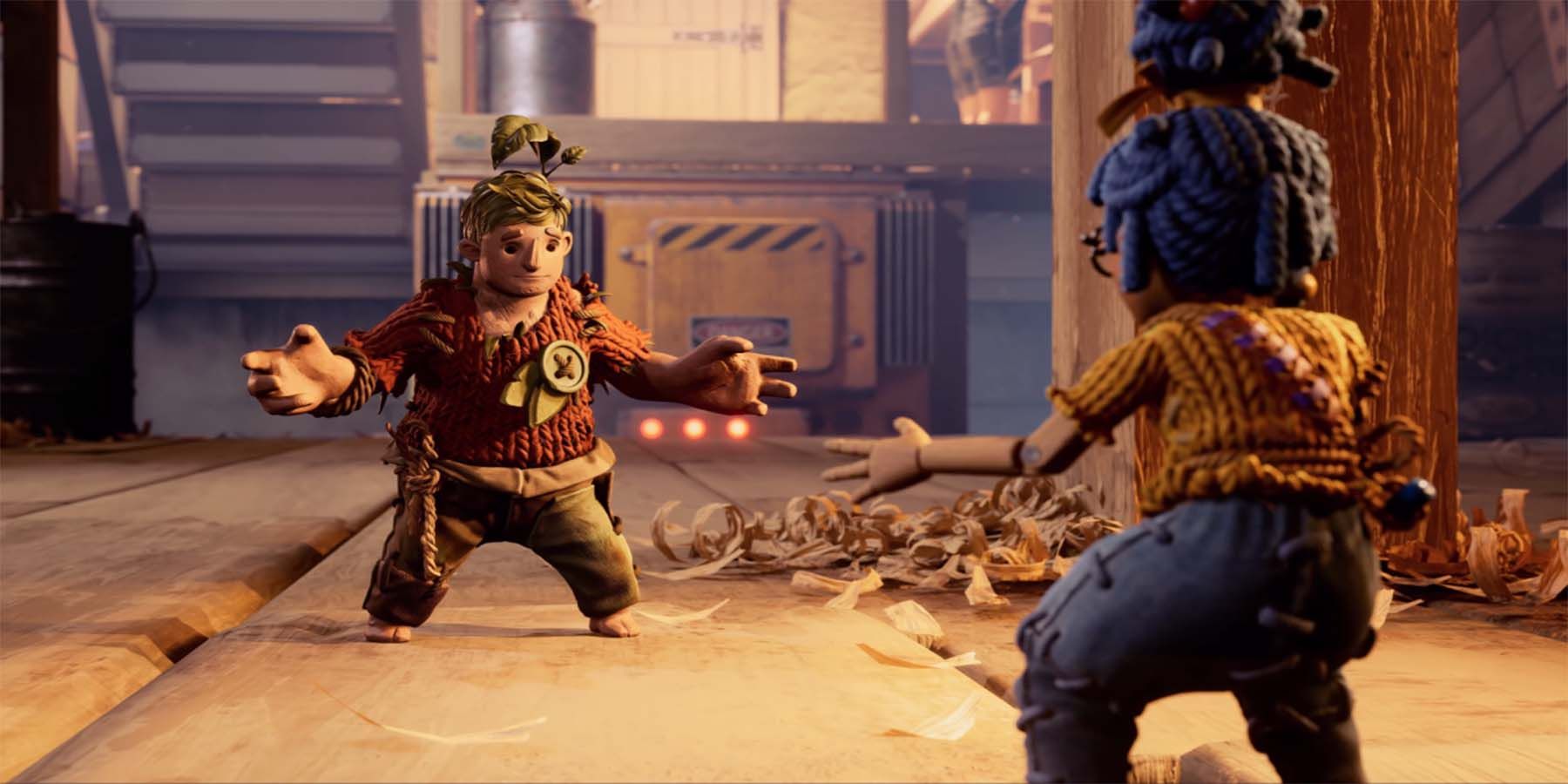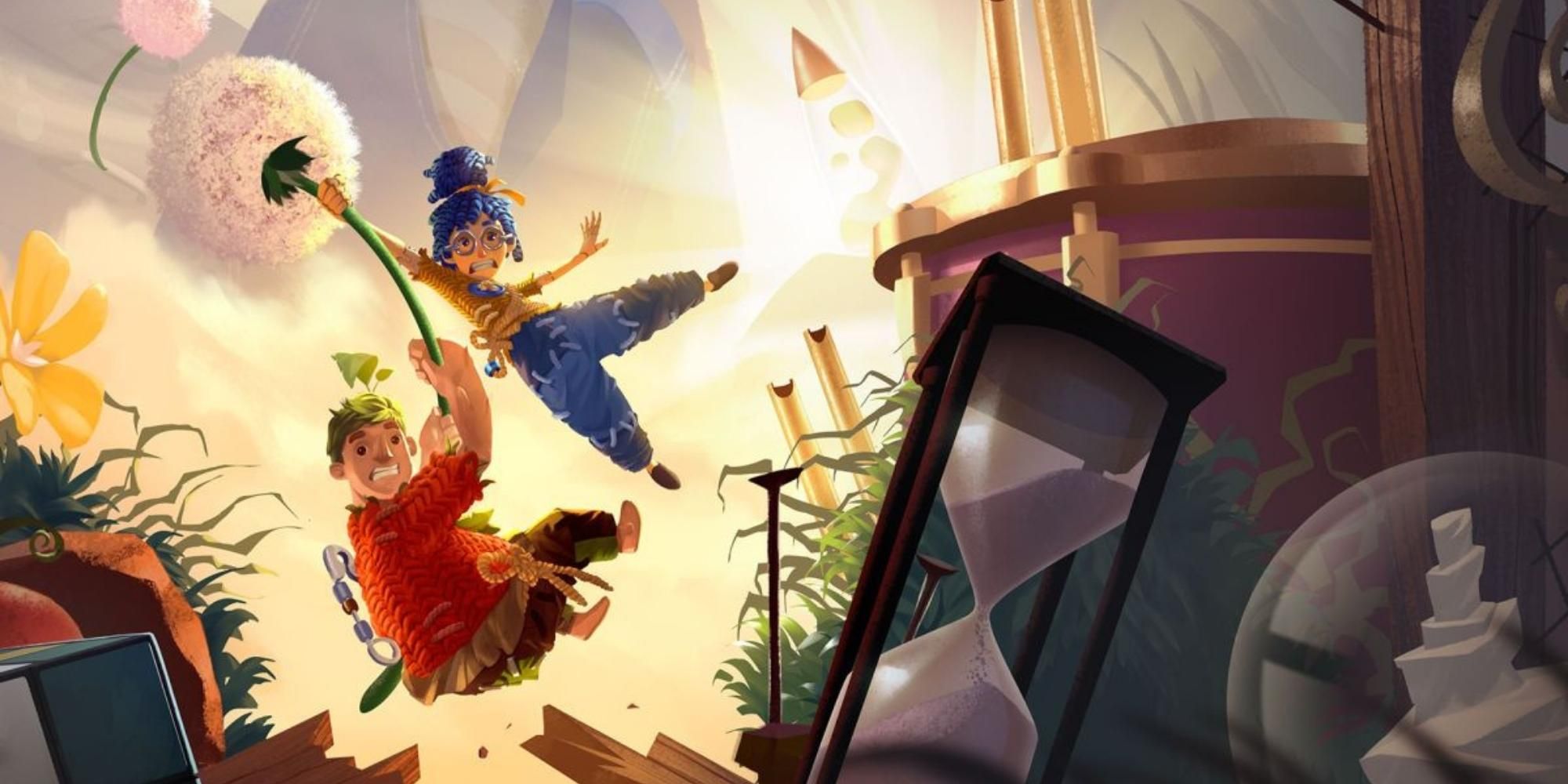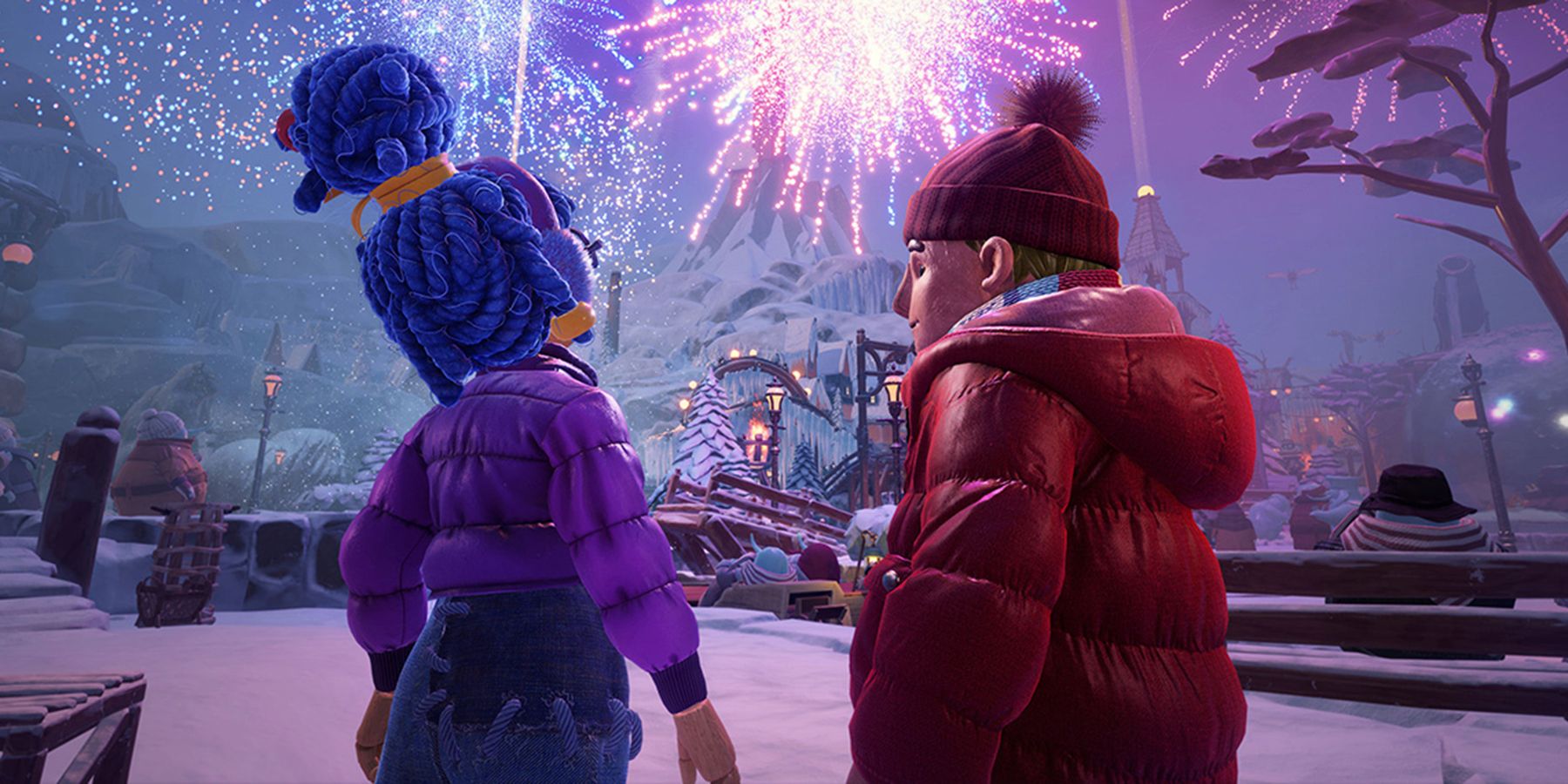It Takes Two, Hazelight Studios' critically acclaimed, Game of the Year winning co-op title releases today for the Switch. Turn Me Up, the developers behind the Switch port, knew that it had high expectations to live up to, but is confidant its adaptation of It Takes Two does the title justice on Nintendo's portable console. So far, the reception for the port has been extremely positive.
Game Rant recently spoke with Josef Fares, the head of Hazelight Studios, and Scott Cromie and Louis Polak from Turn Me Up to discuss their design philosophy, the port's features, Amazon's forthcoming It Takes Two adaptation, and the difference in creative dynamics between games and films. The following transcript has been edited for clarity and brevity.
Q: Please introduce yourselves, and share which character you identify with more strongly: Cody or May.
Josef Fares: My name is Josef Fares, and I am the writer/director at Hazelight and of It Takes Two. And I connect with both of them, so I have a hard time choosing. Being so close to the game, you become part of both. But I will say, the character I connect with most is Dr. Hakim, because I do all the mo-cap for him. So all the dancing and swinging is actually me.
Louis Polak: I am Louis Polak, a producer at Turn Me Up. And I think I would most closely associate myself with Cody. His temperament somewhat matches mine, and I think Scott would agree.
Scott Cromie: Scott Cromie, Executive producer at Turn Me Up Games, and to round things out, I associate most closely with May.
Q: What was the most challenging aspect of bringing It Takes Two to the Switch?
Polak: I think player expectations, this being a Game of the Year, are high. So we wanted to meet those expectations which I feel that we did. That, alongside the uniqueness of every level, and the large environments that are present in the game, as well as the split screen aspect of it, in that it is purely a split screen co-op game. Those were some of the main challenges that we had to make sure we handled in the proper way.
Q: Does the Switch port feature any different specs or additional content compared to the game’s initial release?
Polak: Yeah, it features new voice-overs in four additional languages: Japanese, Spanish, French, and German. It also introduces local wireless, being able to connect two Switches together and play on the go, without the need for any Wi-Fi or television set up. We also did some unique UI-scaling to adapt to the platform.
Q: It Takes Two proves that you can do a moving, narrative-driven game with two players rather than one. What do you think the next step for narrative multiplayer gaming is? A larger party? Exploring new genres?
Fares: I think, first of all, you can explore lots more in co-op-only games. In general, you love to experience stories together. That’s how we originally did it. We tell stories to each other. We go to the cinema together. So there’s definitely more to explore there? Like how to tell stories, but I definitely think you can expand it with more with a multiplayer-type story.
The problem is, the more players you go with, the harder it is to control the story. It’s almost like the players are creating their own story. So it’s really hard to have control over the pace of the story and stuff. It's already hard when you go from single player to co-op. Because we do have it in mind—this is a bigger discussion—but when we write the story, we try to balance the pacing because we know that players talk to each other. They don’t have the same focus that you do when you’re playing alone. So there’s already a lot of complexity in telling the story for two players.
Also, when you are two different characters, you go into the game with different tempers and emotions—you started this interview by asking who we relate to. What happens if one player picks a character they don’t relate to? I definitely believe you can go further than we have, but it’s way more complex.
Q: Games to play with a significant other seems to be a neglected space in video game design, but It Takes Two has proven itself very popular with couples. Was it designed with couples in mind?
Fares: Not really with couples in mind, but with co-op in mind. This game, Hazelight's games, are created, and written, and designed, from the beginning, as co-op only. And this isn’t a game with a single player campaign that adds a split-screen, or a classical drop-in drop out. You cannot play it alone. You cannot start a game by yourself. You have to play together all the time. So from that perspective, we knew that’s the game we wanted to make. So from the perspective of the story, and the relationship…. But I would argue it’s not only couples playing this game. It’s everybody. Friends are playing this game. It wasn’t in our mind to do couples only.
I just remember when we tested the game internally, they reacted like “Oh s***, these guys have something to work on.” They are not really on the right side of their communication skills, and as Dr. Hakim says, “communication is very important in a relationship.” Everybody knows this who is living in a relationship. So we realized, "Oh s***! This could actually be a kind of relationship test," and it is! Once you are playing it with somebody very close to you, whoever it is, it kind of tests where your relationship is. Whether it’s your friend, or spouse, or child. I think it's a really good first date thing as well.
Q: It was recently announced that the It Takes Two movie adaptation would be appearing on Amazon. What’s next for the franchise? And do you have any insights about the film?
Fares: Yeah! We talk to the guys working on the script. Obviously, it’s very early and very hard to know. Hollywood can be a bit tricky sometimes. I’ve been involved with these guys back during my time in the movie industry. It’s a lot of talk sometimes. But they seem pretty serious about the script. I think it will be a really cool thing. But right now, I am fully focused on the next project, to be honest. But I hope something cool comes from it! When we had the last talk with the writers, we seemed to be getting along. And I gave them some ideas of what I think, and where the script could go? But it’s still very, very early in the process.
Q: Josef, you have famously encouraged developers to “f*** things up.” What advice do you have for young creatives looking to break the mold?
Fares: It’s actually “f*** s*** up!” It sounds like I’m just being silly, but whenever somebody new starts at Hazelight, I tell them “It’s time lose all your brain cells.” What I mean by that is, what I really want people to understand, is that people are way more creative than they think. It’s about filling them with this confidence that there is this creative craziness within them that needs to come out.
So when I say “f*** s*** up,” I mean break the rules. Believe in your ideas. Don’t listen too much to others’ opinions, or become too dependent on what people say and think. With that said! I don’t mean “f*** the audience.” No! Make sure the audience loves your game. Don’t try to make a game you think the audience will love. Really follow your passion. It’s a word used a lot, but I think it is really important to keep on believing in your vision. Go with it and trust your ideas. Don’t believe in old design ideas.
When people come to me, especially experienced, older people and say “oh this is how you do a game—” it’s like, “goodbye, see you tomorrow!” I’m not interested. Because we don’t know how to make games today. We have an idea-ish. We have some rules to follow, some systems that we can lean on, but at the end of the day, there is so much to be explored.
Even movies have a lot to explore. But games have an extreme amount of stuff that needs to be explored. So I say go outside your comfort zone. Do something that surprises you. Shock yourself. I think that’s a good approach.
Q: Along similar lines, you have described It Takes Two as a “a f***ed up game,” albeit in a good way. Were there any sequences that went too far that you decided to cut?
Fares: Yes! It’s actually the ending. We changed the ending of It Takes Two, and the original is actually out there on YouTube because somebody went into the dev kit and found it, but it’s really not polished and not in a good state. But the reason it didn’t work is that we switched up the game mechanics too much, and it felt out of context. It really didn’t convey what we wanted in the end. Also! The elephant scene, which is very popular now, was way more violent in the beginning, and we pushed it back a little bit. And that's not because of how people reacted to it; it's just that it would steal too much attention. I love that scene. I think it's nice.
Q: How would you compare the creative processes of making a movie versus making a game?
Fares: I will make movies in the future as well, but I often say, when I want to go on vacation, I’ll make a movie. It’s so much easier. Any filmmaker who says otherwise is bulls***ing you. We know how to predict movie production. We’ve done movies for over a hundred years, so we know the process. From the early 1920s to now. It’s still hard to make a movie, but it’s not even close to making a game. It’s almost like we are exploring everything again. It is hard to calculate how will this mechanic work, especially if you’re doing something new and different.
Collaboration in movies is still important, but with games, it needs to be even tighter. Everybody needs to be on the same wavelength. It’s almost as if everybody’s contribution is more important. In movies, you can easily change out people, but in games, everybody needs to be on the same track.
And then, the obvious difference is that movies are a passive medium, and games are an interactive medium. And interactivity always makes it way, way, way harder. Because when you are done with your movie, it’s a passive experience. The audience just sits and watches. In a game, they are f***ing around with everything. It would be like having people present on set, moving the cameras, playing with the actors. You want to say “No, no, no! Don’t touch the actors, please!” but that’s not how it is in games.
Everything is harder in a game. How do you control pacing? The player can stop and go do something else that destroys all the pacing. If it were a movie, the audience would go “F***, the pacing is off, what’s going on?” but you have to account for that in games.
I know that the movie industry is under-appreciating what games are about, what they are doing, and what they can do. At the end of the day, people want to be emotionally touched. And I think that games can have a stronger emotional touch than a passive medium.
Q: Is there anything else you would like readers to know?
Fares: I would mention the new languages on Switch! Japanese, French, German and Spanish! I heard the Japanese audio and it sounds really nice.
[END]
It Takes Two launches today for Nintendo Switch. It is also available on PC, PS4, PS5, Xbox One, and Xbox Series X|S.



